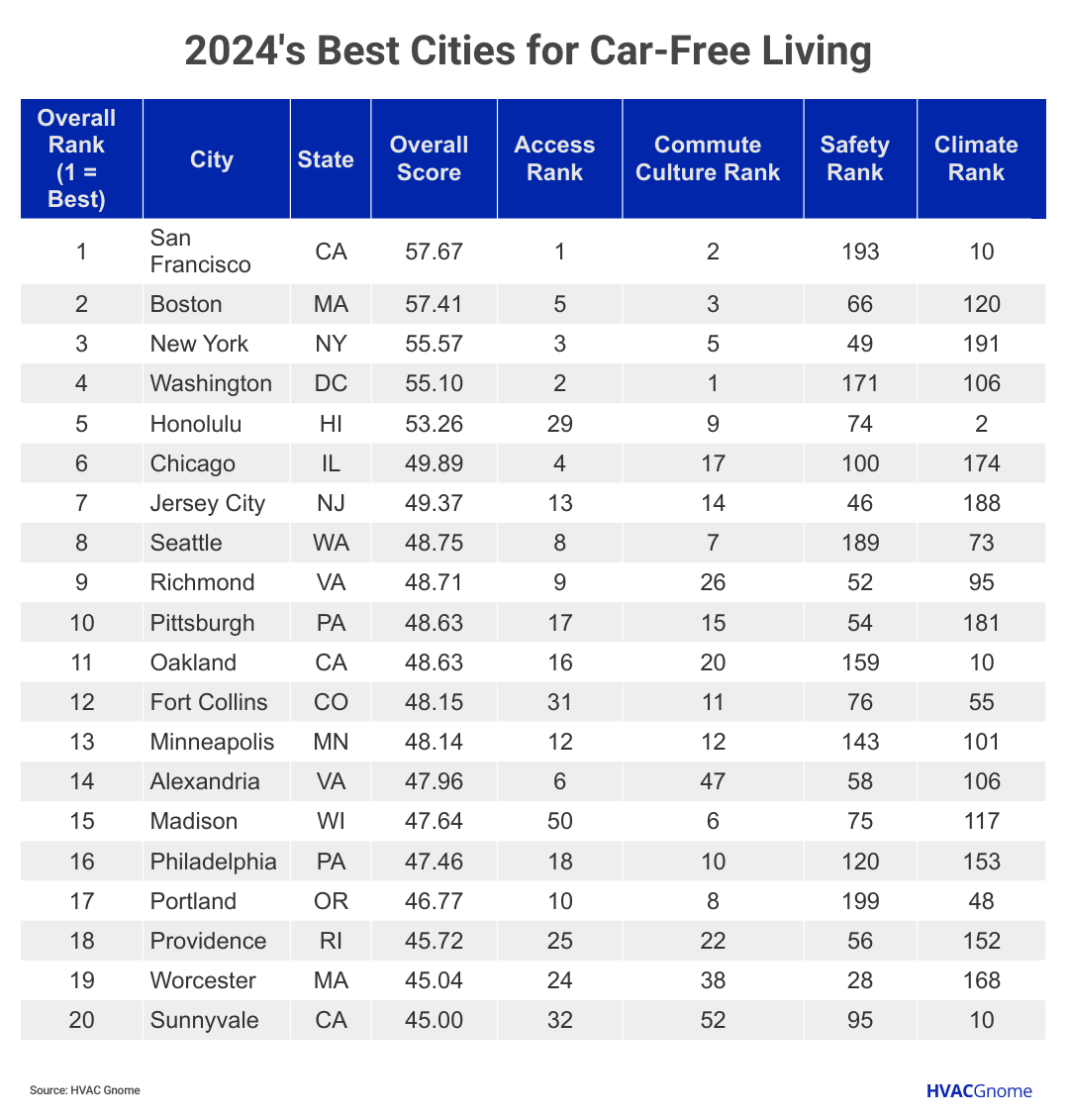
2024's best cities for car-free living
In a country where the car is king of the road, which cities are the best for living without a set of wheels?
With over one-third of Americans eager to abandon their automobiles and new car-free neighborhoods popping up to meet the demand, HVAC Gnome ranked 2024's best cities for car-free living.
We compared the 200 biggest U.S. cities based on 4 categories: walkability, bikeability, transit ridership, and pedestrian safety, among 23 total metrics.
Stroll through our ranking and learn how we ranked the cities in our methodology below.

Here is a breakdown of the top 5
No. 1: San Francisco | Overall Score: 57.67
Walk Score: 89 (Rank: 1)
Transit Score: 77 (Rank: 2)
Bike Rental Facilities per 100,000 Residents: 5.27 (Rank: 3)
Share of Residents Who Ride Public Transit to Work: 27.8% (Rank: 4)
Share of Residents Who Walk to Work: 11% (Rank: 3)
Fun Fact: JFK Promenade is a car-free route running through the iconic Golden Gate Park.
No. 2: Boston | Overall Score: 57.41
Walk Score: 83 (Rank: 4)
Transit Score: 72 (Rank: 3)
Share of Residents Who Ride Public Transit to Work: 28% (Rank: 3)
Share of Residents Who Walk to Work: 14.4% (Rank: 1)
Share of Residents Who Bike to Work: 2%(Rank: 13)
Fun Fact: Boston claims to be "the birthplace of public transit in America" and is home to the first subway tunnel in North America.
No. 3: New York | Overall Score: 55.57
Walk Score: 88 (Rank: 2)
Transit Score: 89 (Rank: 1)
Number of Scooter Rentals: 2 (Rank: 4)
Share of Residents Who Ride Public Transit to Work: 49.7% (Rank: 1)
Pedestrian Fatalities per 100,000 Residents: 1.36 (Rank: 49)
Fun Fact: New York has been bringing music underground — literally, to its subway — since 1987 with the MTA MUSIC program. Hundreds of artists audition annually to entertain riders across 40 locations in NYC's transit system.
No. 4: Washington D.C. | Overall Score: 55.10
Bike Score: 70 (Rank: 13)
Walk Score: 77 (Rank: 5)
Transit Score: 69 (Rank: 5)
Number of Scooter Rentals: 4 (Rank: 1)
Share of Residents Who Walk to Work: 11.3% (Rank: 2)
Fun Fact: Beach Drive at Rock Creek Park was made fully car-free in 2022.
No. 5: Honolulu | Overall Score: 53.26
Walk Score: 66 (Rank: 26)
Transit Score: 56 (Rank: 12)
Bike Rental Facilities per 100,000 Residents: 4.05 (Rank: 9)
Share of Residents Who Walk to Work: 8.2% (Rank: 10)
Share of Residents Who Carpool to Work: 13.1% (Rank: 9)
Fun Fact: Honolulu opened its first metro rail system in the summer of 2023, making it the first new rapid transit system to open in the U.S. in nearly 20 years.
Public transit, dedicated bike lanes are key in car-free cities, no matter the size
Dense, walkable cities like San Francisco (No. 1), Boston (No. 2), and New York (No. 3) walked, bused, and biked to the top of our ranking, with impressive public transit and substantial communities living car-free.
- Richmond, Virginia (No. 9), stands out as the only city in the top 10 without a light rail or street trolley system. River City rolled to the top due to its big biking culture and acclaimed rapid bus transit system.
- Many top-ranking cities, such as San Francisco (No. 1), Washington (No. 4), and Seattle (No. 8), also faced some of the highest rates of bike thefts. Residents of Portland, Oregon (No. 17), dealt with the most bike thefts — nearly 296 per 100,000 residents.
- In 2019, the Kansas City Metro pioneered the zero-fare bus movement. Nine cities in this ranking — such as Richmond, Virginia (No. 9), Worcester, Massachusetts (No. 19), and Tucson, Arizona (No. 25) — were fare-free at the time of writing.
Sprawling Southern cities, such as Jackson, Mississippi (No. 198), and Memphis, Tennessee (No. 199), swerved to the bottom of our ranking, alongside Mobile, Alabama, in last place. Carless residents aren't so mobile in these cities, which lack the infrastructure to keep pedestrians and cyclists safe.
- Memphis disappoints with the 3rd-highest rate of pedestrian fatalities behind Macon, Georgia (No. 192), and Fort Lauderdale, Florida (No. 150). Thankfully, local organizations in Memphis are making efforts to curb traffic violence with streetscaping projects.
- 3 Texas suburbs — McKinney (No. 117), Grand Prairie (No. 158), and Pasadena (No. 182) — lack a public bus service, leaving residents disconnected from the greater Dallas-Fort Worth and Houston metros. Having no bus transit access can be particularly challenging for low-income families living in McKinney's food desert.
Behind the ranking
First, we determined the factors (metrics) that are most relevant to rank the best cities for car-free living, and then assigned a weight to each factor based on its importance and grouped those factors into four categories:
- Access
- Commute Culture
- Safety
- Climate
For each of the 200 biggest U.S. cities, we then gathered data on each factor from the sources listed below the table here.
Finally, we calculated scores (out of 100 points) for each city to determine its rank in each factor, each category, and overall. A city's Overall Score is the average of its scores across all factors and categories. The highest Overall Score ranked "Best" (No. 1) and the lowest "Worst" (No. 200). Note: The "Worst" among individual factors may not be No. 200 due to ties.
Final thoughts
No one likes sitting in traffic — especially with today's gas prices.
Gas aside, owning a vehicle can be a big burden on your bank account. Car ownership costs increased by over 13% between 2022 and 2023, after increasing by 11% the year before.
Researchers have found that public transportation is both cheaper and safer. Some cities are experimenting with bold "open streets" concepts, designating temporary or permanent car-free spaces to improve pedestrian and cyclist safety.
Choosing public transportation over taking your personal vehicle is a better option for the environment, too, reducing emissions by 45%. Cities participating in car-free days saw significant improvements in air quality, with carbon dioxide levels reduced by as much as 60% on the event days.
This story was produced by HVAC Gnome and reviewed and distributed by Stacker Media.



